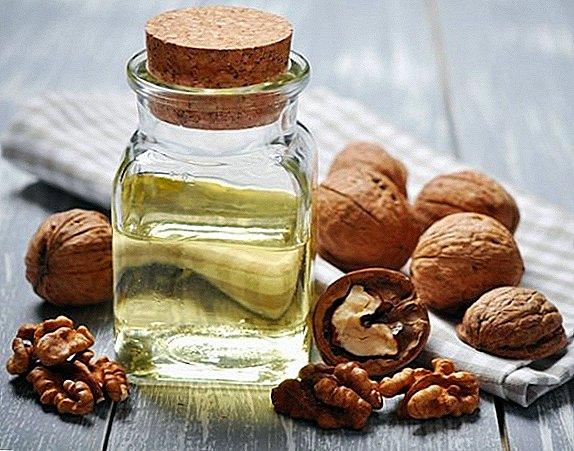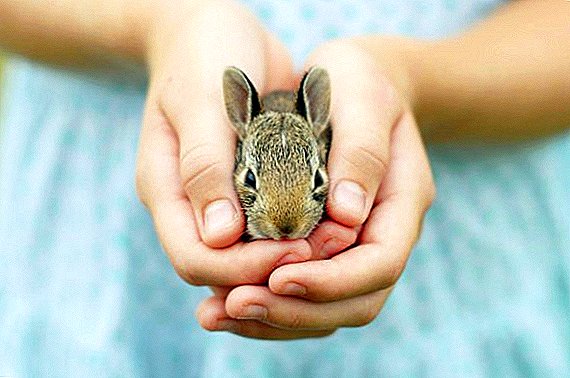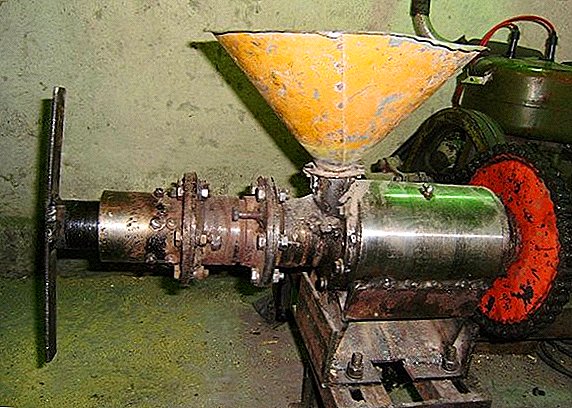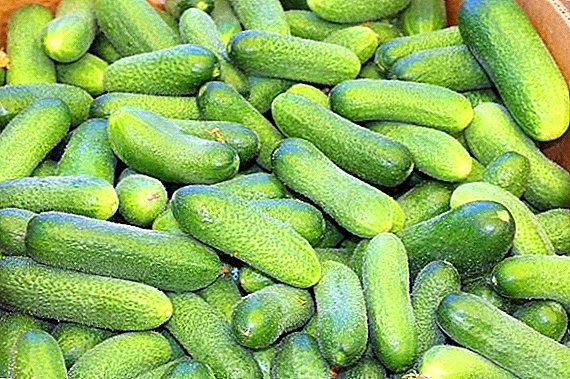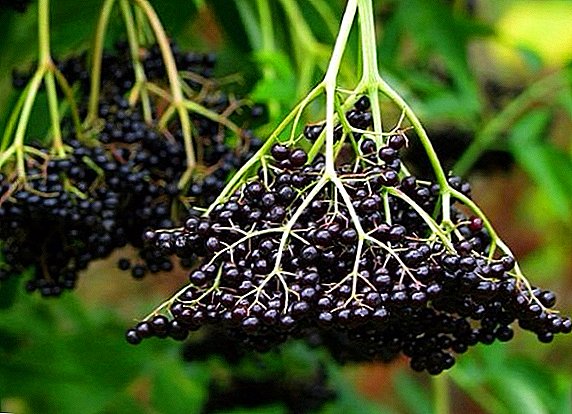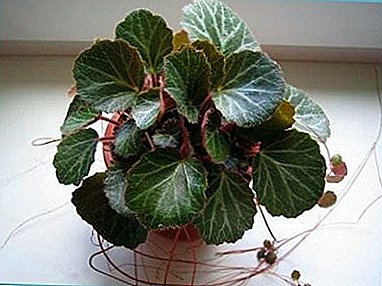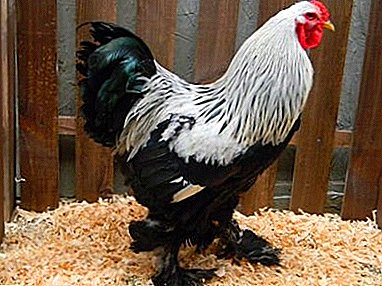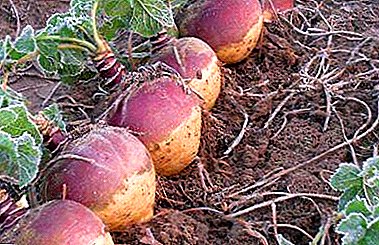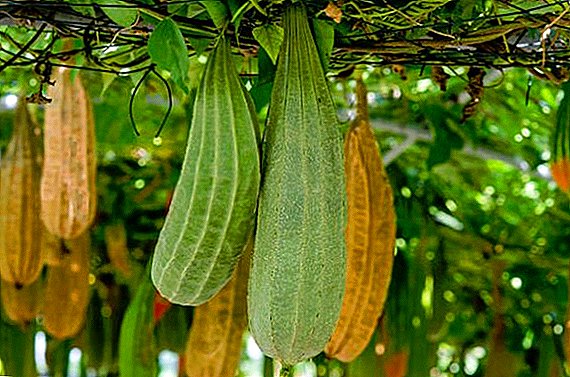 What is lyuffa, few know, and even more so about its benefits and applications. But for those who want to plots of exotic, this amazing plant from the pumpkin family is simply necessary.
What is lyuffa, few know, and even more so about its benefits and applications. But for those who want to plots of exotic, this amazing plant from the pumpkin family is simply necessary.
His secret is not so much in decoration as in the uniqueness of the fruit. They prepare delicious dishes and natural washcloths. And you can do all this at home. Let's try to figure out how to grow loofah from seeds, what it is in the care and what is the use of it.
Sowing seeds for seedlings
Botanists classify Luffa (Luffa) to the genus of grassy vines. In the native tropics of Asia, it develops up to five meters in height, and in temperate climatic latitudes, plant growth is more restrained. However, it is characterized by a long growing season.
Consequently, agronomists advise in the cultivation of exotic crops to give preference to the seedling method. Thus, early, generous harvests become reality.
Did you know? Depending on the varietal variety, fruit loofah is used in cooking and in various industries. For example, from the oil, which is found in large quantities in vegetable seeds, fuel is produced, the pulp is used in soap making, fibers are used as filters for cleaning industrial water.

Optimum time for sowing
For early fruits, given the thick, hard skin on the seeds, the germination of loofah must begin in the middle of winter. Already in the first week of February, you can prepare the seeds for sowing, and as soon as small sprouts hatch from them, you should immediately plant.
On average, this period lasts no more than two weeks. But some owners of the "growing washcloth" share their experience with sowing seeds in April. True, in this embodiment, the harvest will be much later. In any case, plan all work with reference to the lunar calendar.
Capacities and soil for planting
The Asian thermophilic guest stands out from the pumpkin soil and planting requirements family. It turns out that culture does not like transplants very much, it prefers only fertile and loose earth.
Experts advise to germinate a capricious plant in plastic cups. But when choosing them should take into account the volume of future seedlings, it is desirable to use containers with a diameter of up to 7 cm. 
Important! Luff is not sown by beds. For the needs of one family, two plants are enough.The soil for seedlings is prepared from an equal amount of leafy ground, river sand and upper layers of peat. But many hostesses consider this method slightly outdated and advise a more convenient technology.
It consists in the use of purchased peat tablets or pots. For luffa, such an agrotechnical cultivation will provide the necessary nutrition until the transplantation of the seedlings to a permanent place, besides, the sprouts and roots are not injured in the process.
Seed preparation
In order for a sponge to grow from the loofah, the seeds must be carefully prepared for sowing. After all, having appeared in the adverse environment, they can not give at all shoots. The first thing the agronomists advise is to soak the seed for several days.
To do this, use a weak solution of potassium permanganate, aloe juice or plain warm water with a growth stimulator. Emistim, Kornevin, Ecosil and other drugs are suitable as a last ingredient. 
Important! Too much seedlings luffa painfully undergo a transplant to a permanent place. This is because being in pots, sprouts suffer from a lack of nutrients, and when they are on the site, due to weakness they cannot adapt to new conditions.
For soaking, the seeds are placed in gauze or cotton fabric and tied in a knot. Then it is dipped in a prepared warm liquid and left near a battery or other heating device. After 7-14 days, the seeds will spill.
Sowing seeds
When planting loofah on seedlings, determine the period of seed spitting. Once they are ready, you can begin sowing. If you have acquired peat tablets for these purposes, they will need to be thoroughly moistened before full swelling.
Then sow the seeds to a depth of 2 cm. Top cup with a tablet covered with identical packaging to create a greenhouse effect.
If you plan to fill the tank with self-prepared soil mixture, planting is done in the same way as in the previous version. Upon completion of work, be sure to cover the pot with a film or a plastic transparent lid.
Sprouting conditions
It is advisable to place the “greenhouse” on the southern windowsill, where there is always heat and a lot of light. Avoid near drafts and open vents. Under favorable conditions, seedlings should appear in 3-4 days.
Important! If you don’t open the seeds of loofah every day for airing, the soil in the cup will be covered with mold.
Seedling care
Luffa in planting and care has similarities with cucumbers. Pumpkin exotic for further development also needs moisture. But the main thing - do not overdo it.
Young seedlings should be watered only when the top layer of the substrate dries in the cup. In no case do not bring it to a state of swamp slurry.
The temperature in the room where loofah grows should be at least 20 degrees. Liana quickly goes into growth and in room conditions is cultivated until about May. 
Hardening seedlings
Grown up shoots must be hardened, otherwise in more severe conditions they may die. The first hardening is desirable to carry out on a sunny warm day after 4 pm. During this period, the outside air warms up sufficiently, and the plant will not receive stress.
It is advisable to take the plant outside every day. If you plan to plant luffa at the cottage, and grow seedlings in a city apartment, place the pots on an open balcony or window. In the open air, seedlings with time can be left for 5-6 hours. Only this should be done gradually.
Did you know? In the fruit and foliage of the loofah, vitamin A is one and a half times higher than in carrots.
Planting seedlings in open ground
Thermophilic moydodyr garden is very sensitive to changes in soil, climate and care. Let us analyze the main mistakes of summer residents and figure out how to plant the loofah correctly. 
Optimum terms for landing
When the fifth leaf develops on the liana, it is time to transplant the seedlings to open ground. It is important to take into account the daytime temperature outside, since the tropical culture is completely not adapted to the cold.
It is desirable that the thermometer rises above 15 ° C, and stable warm weather is established in the yard. In total, plan to transplant no earlier than May.
Choosing a place to grow
It is worth looking in advance at the landing site for loofah, even when the seedlings are satisfied with the heat on your windowsill. And all because there will be a complex of preparatory work before transplanting.
Only a well-lit and protected from the northern winds and drafts zone can please a tropical liana. It is desirable that there were no trees near, because, climbing on them, the vine clings to the fruit, as a result, they rot right on the trunk.
Important! Luffa will not grow in regions with cold rainy summer.
 The soil is needed with neutral acidity, enriched with nutrients, ideally, loose black soil or sandy soil. If there is none, you will have to correct the selected area.
The soil is needed with neutral acidity, enriched with nutrients, ideally, loose black soil or sandy soil. If there is none, you will have to correct the selected area.When choosing a place for transplanting seedlings, it is also worth considering the predecessors and growing crops nearby. Luffa is not recommended to root after melons and pumpkins - they have the same need for food and the same sensitivity to pathogenic microorganisms.
Site preparation before planting
All the preparatory work at the selected site consists of thoroughly digging the soil, fertilizing it, and, if necessary, adjusting it, as well as building a support for the vine. First you need to dig up the site and check the pH reaction.
To do this, you can use table vinegar, sprinkling it on a clod of earth from a 20-centimeter depth. Hiss and foam indicate an alkaline environment.
Too oxidized substrates are adjusted with dolomite flour, cement dust or ordinary lime. From 150 to 300 g of substance are applied per square meter.
Did you know? Washcloths of luffa are valued not only for naturalness, but also for cleansing the skin from dead cells and simultaneous massage.
Regardless of the soil features, the prepared zone is fertilized with a nutrient mixture of 1 bucket of humus (can be replaced with compost), 2.5 tablespoons of superphosphate and taken 1 tablespoon of urea and potassium sulfate.  If the ground is sandy, you need to add more humus. On heavy soils, river sand, hardwood and compost will be needed. When with the ground all the work is finished, you can begin to install a trellis or other support. This is important to do now, because immediately after transplantation the culture will need to be tied up.
If the ground is sandy, you need to add more humus. On heavy soils, river sand, hardwood and compost will be needed. When with the ground all the work is finished, you can begin to install a trellis or other support. This is important to do now, because immediately after transplantation the culture will need to be tied up.
Planting seedlings: the scheme and depth
You already know that lyuffa is a liana and grows in favorable conditions. In our climate, its stems can reach 7 meters in height.
Therefore, when planting it is important to observe the distance between adjacent plants. Agronomists advise retreat up to 1 m.
Landing is carried out in the wells, the depth and width of which is equal to the spade bayonet. At the bottom pour a mixture of equal parts of humus or compost and rooted seedlings. At the same time, it is necessary to carefully cut the glass and push them out of it with an earthen ball with a germ.
Much easier to do this in the case of peat tablets. It is recommended to bury the sprout to cotyledon leaves.
Important! Without regular dressings, the vine will lose its decorative effect. Foliage will become pale and lifeless.

How to care for loofah
A garden sponge, like cucumbers, needs moderate moisture, a lot of heat, regular feeding, reliable support and bush adjustment. We will understand everything in order.
It is interesting to learn about cultivation of such exotic at home: medlar, strelitzia, okra, zizifus, witch hazel.
Watering
Luffa loves moist air and soil. Therefore, it is desirable to irrigate it from a garden hose or from rain installations. The number of waterings for plants depends on the characteristics of the soil and weather conditions. It is important that the top layer of soil was slightly damp, but not soaked. Immediately after transplantation, seedlings can be watered once a week, and when the vine blooms, water treatments increase.
In the future, focus on the status of pristvolny wells. Experienced vegetable growers recommend watering bushes up to three times every week from June through the second decade of September. Then watering is minimized to reduce growing season. According to experts, this trick contributes to the soon ripening of fruits.
Do not pour a lot of water. The root system of exot is located on the surface, like squash, so it will be enough to soak 15-20 cm. 
Important! When the night temperature drops to 5 degrees Celsius, all fruits from the loofah need to be removed. Otherwise, due to the defeat of anthracnose, they will become unusable.
Top dressing
For the season the plant needs about five fertilizers. They spend monthly with a frequency of two times. As a rule, they resort to the root method, watering bushes dissolved in 1 liter of water 1 kg of mullein and 250 g of wood ash.
Alternatively, you can use the infusion of green grass or chicken manure, prepared in a ratio of 10: 1. Also suitable nitrogen-containing solution of two teaspoons of urea and a bucket of water.
Pinching and shaping the bush
Luffa requires constant intervention in the process of its development. In order for the fruits to form evenly, it is recommended to remove the side processes and pinch the central shoot at 4 m.
Also, starting from mid-June, the excess ovary must be removed. Experts advise to leave 5-8 Zelentsov, so that others do not deplete tops. 
Garter to the support
If the fruits are deformed and begin to deteriorate on the vine, pay attention to the conditions for their growth. First, the growing rods need to be tied regularly to the support. Secondly, it is important to straighten the vine so that the ovary freely hangs from the trellis. Only then will the vegetables be large and even.
Did you know? Ripe fruit loofah can be stored for several years.
Harvesting
Young vegetables for cooking are removed from the vines, without waiting for their maturity. Then the fibers in the fruit are soft and pleasant to the taste. If you miss the time of cleaning, do not try the dishes from the loofah. Experienced hostesses make frozen stockings for the winter.
If you plan to make washcloths, remove only ripe vegetables. On them a coarse, very firm brown skin. Over time, it dries and peels off easily, leaving dried fibers. You can dip the vegetables in boiling water for 20 minutes to speed up the cutting of the bark. The inside is washed in very warm water and dried.
This washcloth will last you no more than 6 months. For harvesting seed, ripe vegetables are also needed. They are collected in October. A sign of ripened seeds is the peculiar ringing inside. 
Types of loofah
Scientists distinguish only about fifty varieties of loofah, but from this variety only ostrorebristaya and cylindrical varieties are introduced into culture, since the other species are too small.
Luffa sharp (Luffa acutangula) is a grassy liana with relatively small fruits up to 35 cm in length. Vegetables are distinguished by a cone-shaped shape with clear edges and elastic skin. To tear it off is almost impossible. The species is cultivated mainly for culinary purposes, with only young greens getting to the kitchen. 
Did you know? For many years, before the advent of synthetic materials, loofah fruits were used as fuel and air filters.
The peculiarity of these vines is that they bloom only at night, respectively, and are pollinated by night moths. Agronomists note that the species is very unpretentious, easily adapts to any soil and is very resistant to pathogenic fungi.
Cylindrical luffa It is cultivated mainly for preparation of washcloths. In everyday life, it is called "uterine". The variety has large fruits with a length of up to 70 cm with a tender, milky-colored pulp and thin skin that easily exfoliates. 
Application and use
You can talk about the benefits of luffa for a very long time, because scientists today do not know anything about the harmful qualities of a plant.
But it has already been proven that natural washcloths made from fibers of ripe vegetables stimulate blood circulation, do not cause allergic reactions and skin irritations, have a lymphatic drainage effect and contribute to solving problems of cellulite and stretch marks.
Did you know? China, Thailand, Japan, America, Central Asia, Indonesia, India are the largest producers of loofah in the world.
 Chefs, designers and physicians speak positively about marvelous vegetables. For example, the first learned to cook unsurpassed culinary masterpieces from the tender flesh, flowers and foliage.
Chefs, designers and physicians speak positively about marvelous vegetables. For example, the first learned to cook unsurpassed culinary masterpieces from the tender flesh, flowers and foliage.The latter say that the potential of a plant in society is still underestimated. From the fibers of the fruit, you can make unique vases, ceiling lamps, flowerpots, screens, and even some pieces of furniture.
For people who know a lot about decor, luffa is a real creation of Mother Nature. She, like a vine, in the capable hands of masters can turn into a very unexpected, but unsurpassed object.
Doctors talk about the healing properties of culture. Her juice can be used to treat conjunctivitis, problem skin, anemia, nasopharyngeal and lung diseases. Also noted antipyretic, tonic and immunostimulating effects of loofah.  Pharmacists also speak about the benefits of the plant. On sale you can find a lot of drugs based on the extract and oils of this exotic.
Pharmacists also speak about the benefits of the plant. On sale you can find a lot of drugs based on the extract and oils of this exotic.
Obviously, they will talk about luffa. In the meantime, let's not underestimate what nature has given us for beauty, spiritual and physical enjoyment. Observing all the above recommendations, you will receive a decent harvest of exotic culture and make sure that it is unique.


